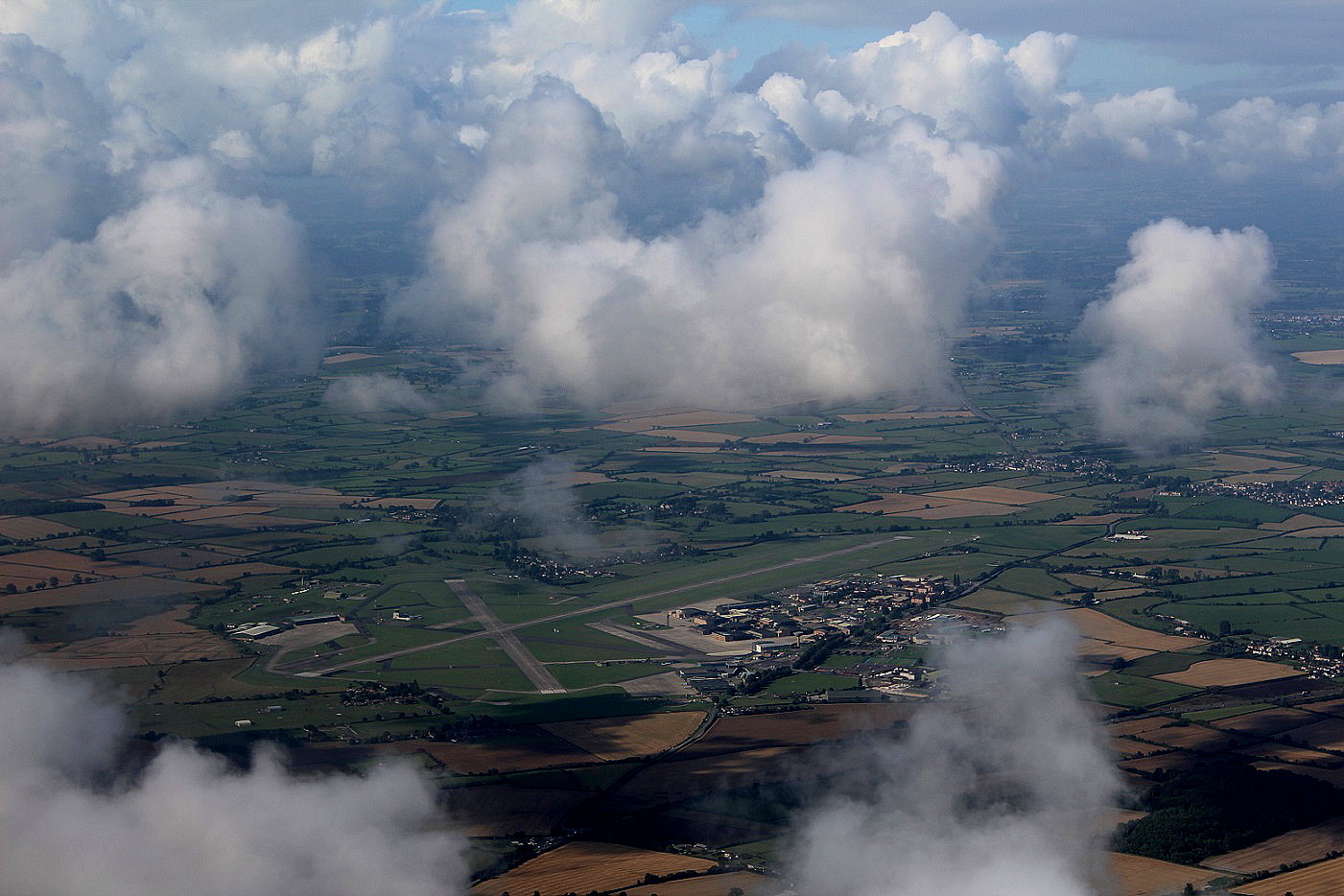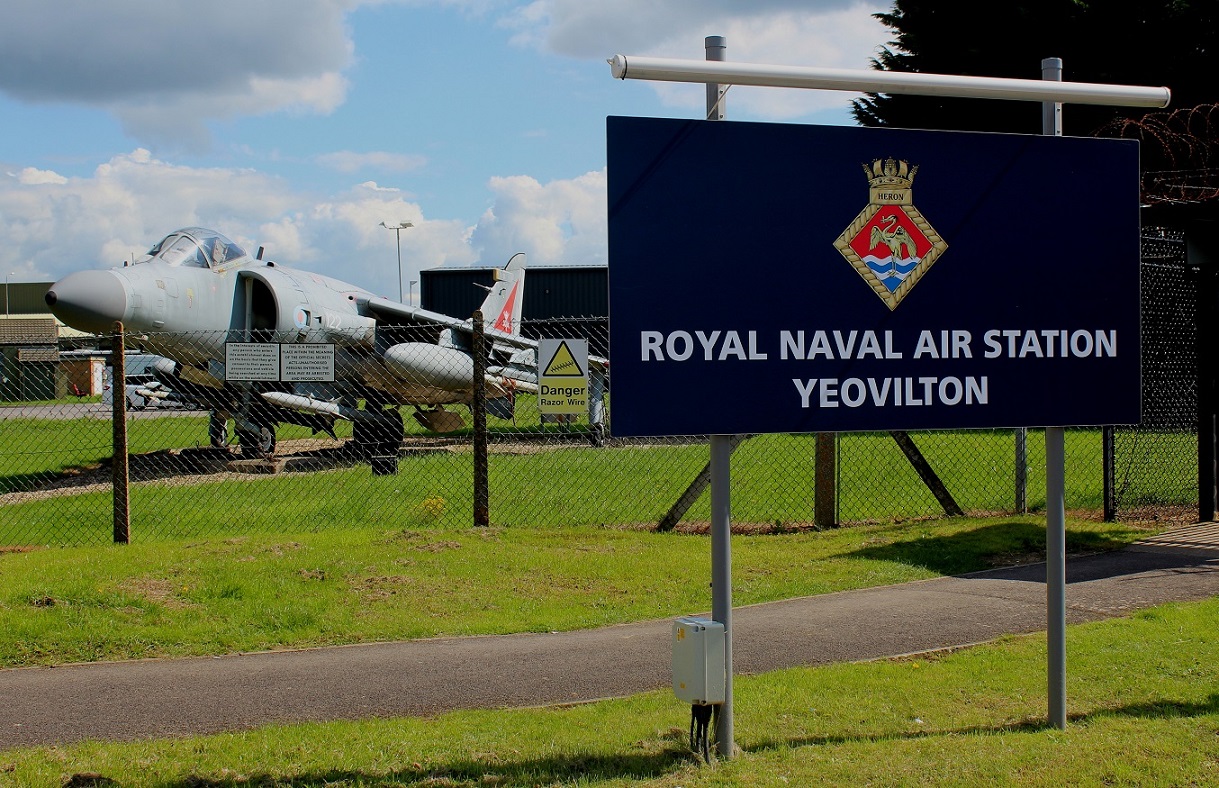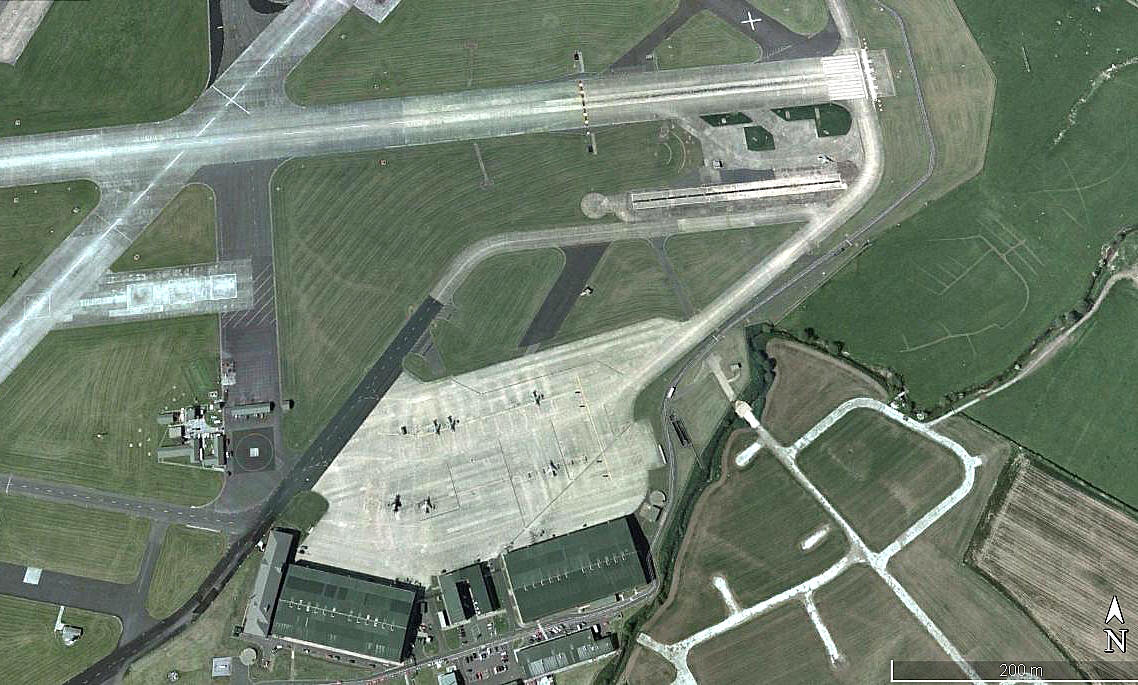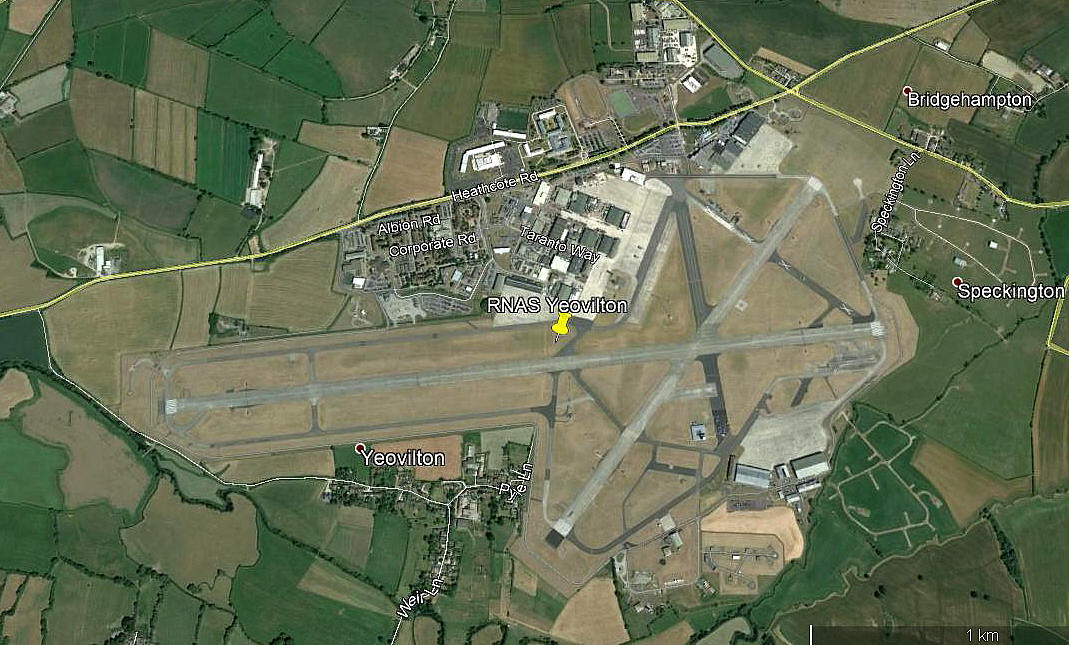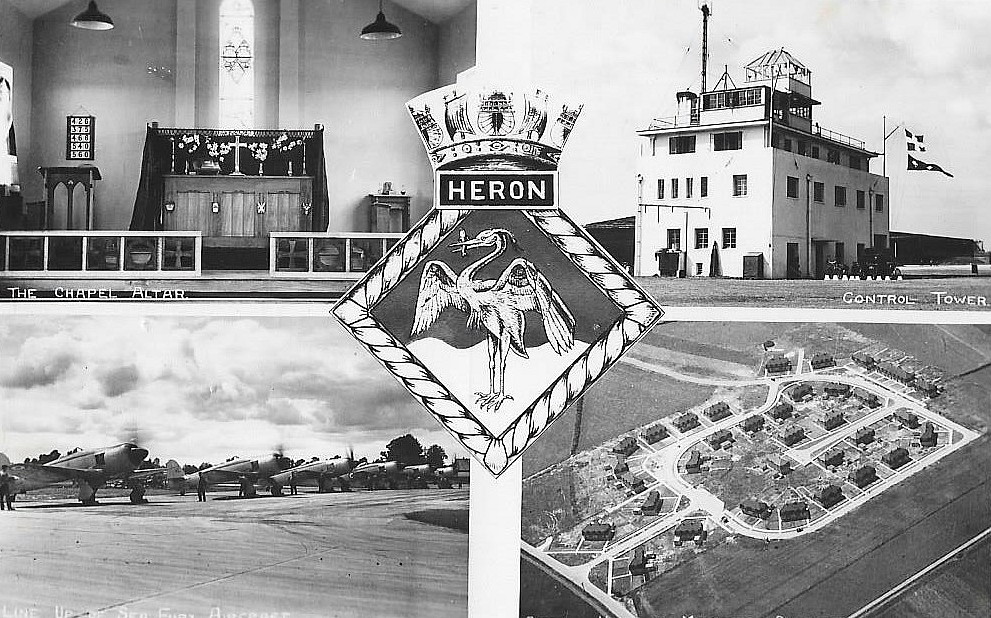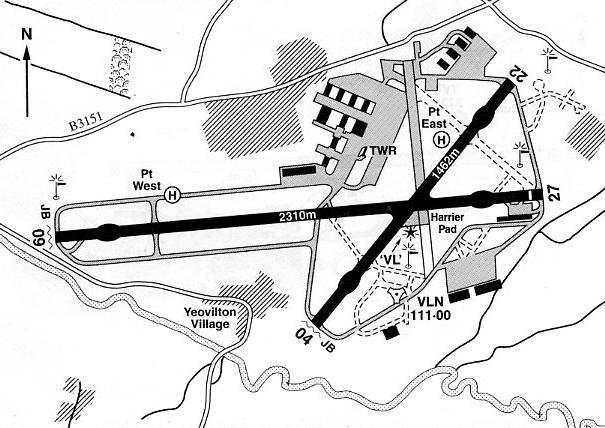Yeovilton
YEOVILTON: Military aerodrome (HMS HERON)
NOTE: See the Gate Guardians and Museums article for more pictures and info.
Note: The first aerial picture by the author was taken through perspex. The second picture taken about three weeks later in September 2015, when driving past, shows the main entrance sign plus the Harrier 'Gate Guardian'.
The third and fourth pictures were obtained from Google Earth ©
Military user: I must try to remember to research the early history of this site.
WW2: RN Fleet Air Arm Fighter School
Note: This picture from a postcard was kindly sent by Mike Charlton who has an amazing collection. See, www.aviationpostcard.co.uk
Post 1945: RNAS HQ Naval Air Command
'V' Bomber dispersal airfield
707 Sqdn (Westland Sea Kings)
800 & 801 Sqdns (Hawker/BAe Sea Harriers)
816 Sqdn (Westland Lynx)
845 & 846 Sqdns (Westland Sea Kings),
847, 848 Sqdns? (Westland Sea Kings also?)
892 Sqdn (MacDonnell Phantoms)
899 Sqdn (Hawker Hunters, Hawker/BAe Sea Harriers),
FRADU (English Electric Canberras, Hawker Hunters),
3 CBAS (Westland Gazelles, Westland Lynx)
Station Flight (DHC.1 Chipmunks, Westland Gazelles, DH.114 Sea Herons)
1975: RNAS (MacDonnell Phantoms & DH Sea Vixens)
Gliding: Listed as operating in 1975 to 2001. RN Gliding Club (HMS Heron Gliding Club) and also the Dorset Gliding Club from 1980 to ? (This latter arrangement didn’t last for long)
Operated by: 2000: Still a Royal Navy aerodrome
Manufacturing: WW2: Westland Aircraft Co (the Westland Ilchester factory was adjacent to this aerodrome)
Location: S of A303 & Podimore, E to SE of Yeovilton, 4nm N of Yeovil
Period of operation: 1914 to -
Note: This map is reproduced with the kind permission of Pooleys Flight Equipment Ltd. Copyright Robert Pooley 2014.
Runways: WW2: 04/22 1111x46 hard 09/27 1061x30 hard
18/36 969x30 hard 14/32 978x30 hard
1990: 04/22 1462x46 hard 09/27 2292x46 hard
2000: 04/22 1462x46 hard 09/27 2310x46 hard
Helipads: 1990/2000: Multiple helipads shown on and to the W of the old 18/36 runway
NOTES: Site of the excellent Fleet Air Arm Museum (See my article on museums)). Also home to the Royal Navy Historic Flight. On the 28th May 1964 HRH The Duke of Edinburgh flew the HS.748 demonstrator G-ARAY into YEOVILTON to both open the Fleet Air Arm museum and the 50th anniversary review of the Station opening.
A MYTH?
There is a story of a Royal Navy jet pilot doing a low inverted pass across the airfield and instead of pushing forward to climb out, he pulled back. Apparently all the controller in the tower heard was a very brief “Shit” before it impacted. A search seems to indicate that nothing like this actually occurred here? The reason for mentioning it is simply to illustrate, (If I am correct), that myth, legend, misinformation and sometimes just downright lies cascade down the years throughout aviation history. As they do in any field of human endeavour of course.
A CAUSE FOR ARGUMENT?
Arguably the most significant Naval aircraft to make its presence felt at YEOVILTON was the Sea Harrier, a type of aircraft initially dismissed by the Naval top brass as being of little interest or use. To quote Robert Jackson from his excellent book Britain’s Greatest Aircraft: “The RAF had its Harriers, and although the Royal Navy had lost interest in V/STOL with the demise of the supersonic P.1154 project and acquired the conventional F-4 Phantom, when the idea of a seaborne Harrier was resurrected at a later date the Navy’s interest was reawakened, although there were those who said that such an aircraft would simply serve as a stop-gap until something better came along. They were wrong.”
Yes indeed, just how wrong can you be? The Naval top brass made an error of judgement here that is so profound that their competence to hold their ranks must surely be questioned?
Again from Robert Jackson: “Developed from the basic Harrier airframe, the Sea Harrier FRS.1 was ordered to equip the Royal Navy’s three Invincible class aircraft carriers. The nose was lengthened to accommodate the Blue Fox A1 radar, and the cockpit was raised to permit installation of a more substantial avionics suite and to provide the pilot with a better all-round view. An initial production batch of twenty-four aircraft, plus three development aircraft, were ordered to expedite testing and clearance, and while the first Sea Harrier neared completion in the summer of 1978 the testing of its entire range of operational equipment was under way in two specially-modified Hawker Hunter T.8 aircraft. The first Sea Harrier FRS.1 took off for its maiden flight from Dunsfold on 20 August 1978; this aircraft, XZ450, was not in fact a prototype but the first aircraft of a production order that had now risen from twenty-four to thirty-one. On 13 November it became the first Sea Harrier to land on an aircraft carrier, HMS Hermes.”
“The second production Sea Harrier, XZ451, flew on 25 May 1979 and became the first example to be taken on charge by the Royal Navy, being accepted on 18 June 1979 for service with the Intensive Flying Trials Unit. No. 800A Naval Air Squadron was commissioned at Royal Naval Air Station, Yeovilton, Somerset, on 26 June 1979 as the Sea Harrier Intensive Flying Trials Unit (IFTU), and on 31 March 1980 this unit was disbanded and re-formed as No.899 Headquarters and training squadron.”
AN UNEXPLAINED COMPULSION?
To somebody with a rather cynical approach to life, (such as myself), it often appears that the first priority of the military top brass in the UK since World War One, (and possibly before ?), and well ahead of any inconvenient operational issues, (such as wars, which just get in the way), is to always re-number, re-define and constantly move things around. Quite why they feel this compulsion has yet to be explained?
A SIGNIFICANT CONTRIBUTION
Quite probably the zenith of the Sea Harrier’s operational career came about in the Falklands war. As Robert Jackson states: “Armed with Sidewinder AAMs, the Sea Harrier FRS.1 distinguished itself in the 1982 Falklands war. At the height of the campaign, on 21 May 1982, Sea Harriers were being launched on combat air patrols at the rate of one pair every twenty minutes.” This war, as so many since promoted by British Prime Ministers, was a put-up job having nothing to do with the “declared aims” being promoted to the British public. Although the general feeling was that this would be a push-over, easily overcome, I can remember at that time arguing that the Argentine military forces would prove to be a formidable enemy and this proved to be the case. But of course, our press and media simply hate reality to get in the way of a 'good' story.
It all seemed so obvious, with Argentina being armed by the USA and the French especially, with so many formidable weapons. Plus of course it is always a big mistake to dismiss older weapons as being obviously inadequate. The supposedly obsolete Douglas A-4 Skyhawks flown by determined Argentinian pilots proved to be very effective. This was of course taking place in an era still dominated by ‘Cold War’ preconceptions whereby, by and large, the only answer to any advance on either side, was to match like-with-like.
GENTLER TIMES
It appears that the Procter Kittiwake G-BBRN of the RN & Royal Marines Gliding & Soaring Association, and the DHC.1 Chipmunk G-BCHV were all based here.
We'd love to hear from you, so please scroll down to leave a comment!
Leave a comment ...
Copyright (c) UK Airfield Guide















